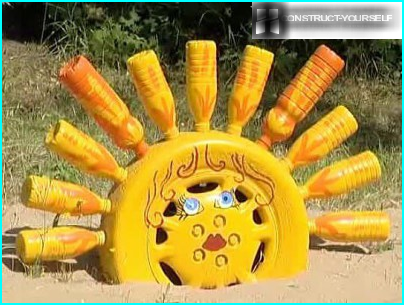
A beautiful pond is the dream of every vacationer, who draws in the imagination of an idyllic scene with crystal-clear surface reflecting the sun’s glare. But we must not forget that any pond quickly blooms and polluted, and before the summer resident raises the question – how to clean pond or small pond? Because only careful maintenance will guarantee you a clean, clear pond with healthy inhabitants.
The contents
Causes of pollution of the pond and solutions
Bad waterproofing
Sometimes the contamination of the water body may be due to violation of waterproofing system. Concreted the bottom or the walls may crack and through the crack begins to enter the soil. The main reason for the occurrence of cracks can be ground subsidence or improper preparation batonrouge solution.
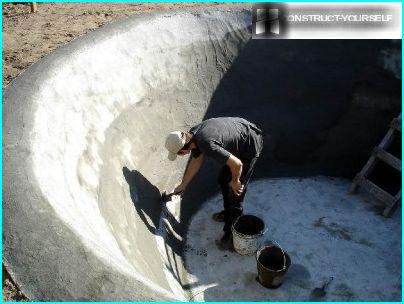
Eliminate the leak, close up the cracks with sealant in two layers — now the pond is sealed
To resolve this problem you need to drain the pond, clean the cracks and fill them with sealant in two layers. For large damage, you need to strip them and first cover with mastic, and then a second layer of sealer. But the repair is not a guarantee that the concrete base of the pond will not provide cracks again. The surest way to eliminate the leak – is laying special plastic form.
The control of algae
The appearance of greenery on the surface of the pond becomes one of the main problems to care for them. The water surface starts to turn green because of the proliferation of small algae. Algae only worsen the appearance of the pond, but will not harm its inhabitants. Cleaning the ponds from algae should be carried out regularly, chemical, biological or mechanical means.
Mechanically remove algae with the help of the rake, reeling and pulling them to shore. Biological method involves the planting along the banks of the pond plants that contribute to shading and creation of unfavorable conditions for growth of algae. Chemical method is more radical and involves the use of special chemicals – algaecides or dyes.
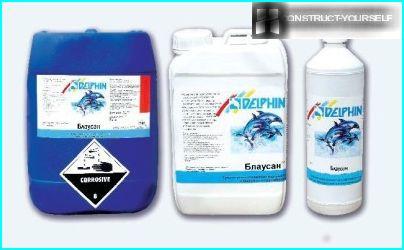
Each type of drug affects a certain plant, thus you can get rid of one species without affecting the other
The use of special filters
Cleaning of ponds and reservoirs with the help of special filters the most convenient and effective method. Enough to put the extract filter to the pump and periodically to clean it. Filters are like regular mud, cleansing the water of large debris and sludge and biofilters with UV lamps, which prevent the growth of harmful bacteria and help to prevent fish disease.
The principle of operation of cleaning filters is composed of suction and filtration of the water through the skimmer, with the filtration of debris from the bottom and the surface of the pond.
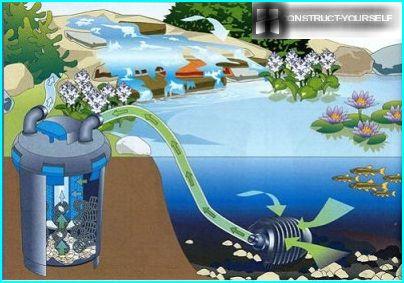
The filter, of course, helps. But to use it you need to bring electricity, but it is not always possible
Here is a way to make a filter myself:
Use specialised cleaner
The cleaning of the pond with their hands possible with the help of special vacuum cleaner that collects debris as the pond surface and from the bottom. The principle of operation of the vacuum cleaner consists of a suction water, filtration through a special filter and output to the clean water through the hose with the other hand.
Cleaning the pond from sludge is carried out using a bottom cleaner, it looks like usual, but without the internal cleansing of the filter. Bottom vacuum sucks water into the camera and filling shuts off automatically capacity from sludge need to release.
How to prevent the appearance of turbidity in the pond?
Timely cleaning of water reservoirs of the above methods will guarantee the purity of the water and the health of living of its inhabitants. But the severe pollution of the pond it must be free from water, clean the bottom, algae and underwater rocks with a hose and then fill it with clean water.
Sometimes from the bottom can rise to the sludge and the water in the pond darkens or gets a dark shade, for example due to the activity of the fish or a large water pressure. To prevent this, you can add in water a special chemical compound faculaty that contribute to the settling of dregs in the bottom of the pond.
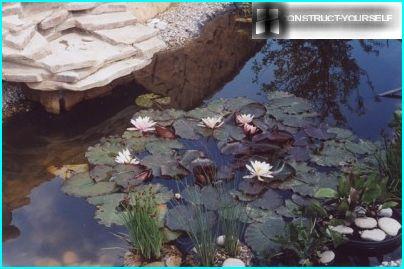
When water turbidity due to silt, the pond acquires a brownish tint
Winter-spring routine of care
Depending on the volume of the pond the question of the wintering inhabitants, in a big pond the fish are in no danger, you just give them a little help. By having a small pond the fish will have to move in a home aquarium. Caring for the pond in the winter is to first clearing it of debris, prevention of freezing of the entire surface of the water.
To prevent accumulation of harmful underwater gas and oxygen in the ice enough to do one large hole and make sure that it does not freeze or lower a special heater, but for small ponds, you need to pull all the water for the winter.
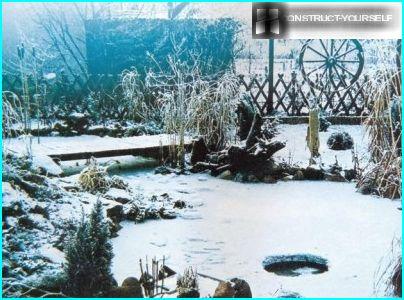
The hole in the pond in the winter will help the fish and the algae oxygen
But when spring comes warm days, there is a need to bring the pond up after a long winter. You need to check the wiring and the pump. To remove from the surface mesh, if it was, remove debris and clean the pond.
In the last month of spring can be planted plants. Easier to plant them in baskets or boxes, will be sufficient to remove them when cleaning the pond. It is also worth to feed overwintered, weakened underwater plants a special fertilizer. A small bag of fertilizer is placed in a layer of gravel under the plant.
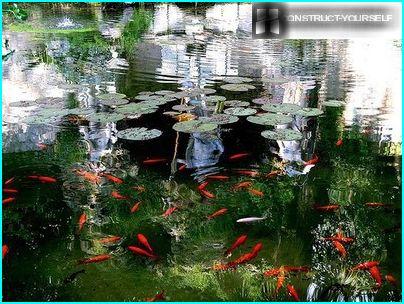
In the spring you begin to feed the fish as soon as they begin to rise to the surface. At this time the fish is weakened, so 1 every 2-3 days give dry artificial feeds, adding chopped worms and Daphnia
All these simple activities will help you to enjoy the beauty of your pond for many years.






